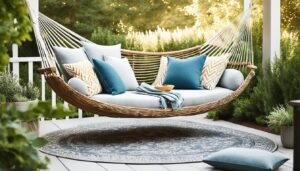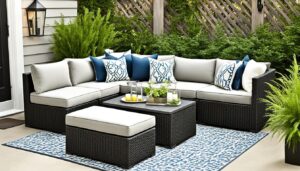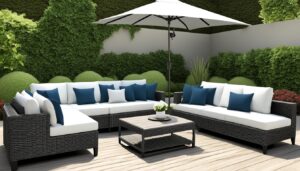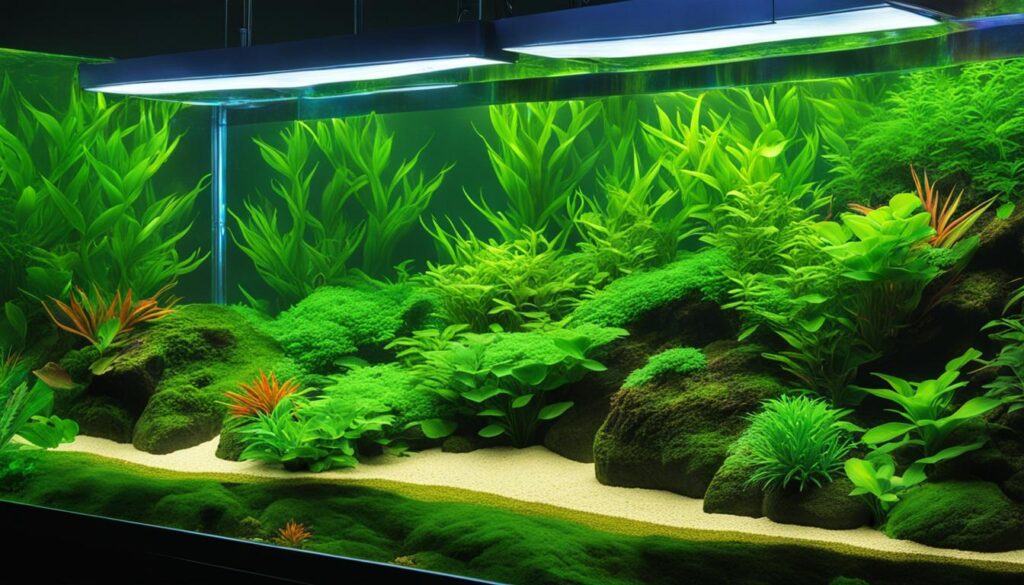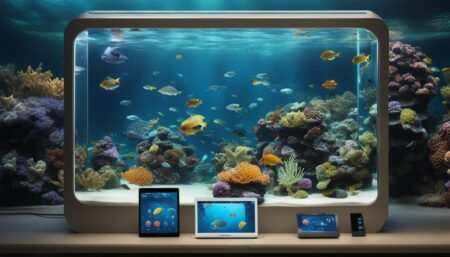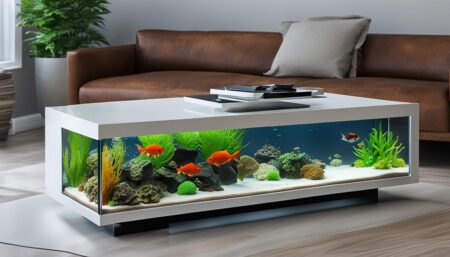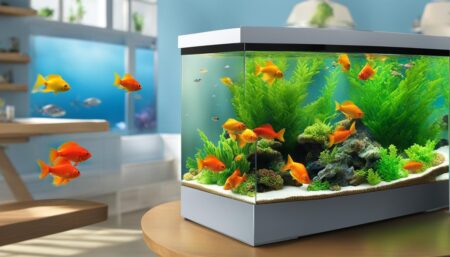Welcome to our ultimate guide to aquarium lighting for plants! If you’re a proud aquarium owner and want to ensure the growth and health of your aquatic plants, lighting plays a crucial role. In this guide, we’ll explore the importance of aquarium lighting for plant growth and provide you with valuable tips on choosing the right light bulb for your aquarium plants.
Key Takeaways:
- Aquarium lighting is essential for the growth and health of plants in your aquarium.
- Plants require both sunlight and artificial light to undergo photosynthesis and produce food.
- Choosing the right aquarium light bulb is crucial for promoting healthy plant growth.
- Consider tank size, light intensity, and color temperature when selecting lighting for your aquarium plants.
- The Aquarium Co-Op Easy Plant LED is a recommended option for its versatility and energy efficiency.
The Importance of Aquarium Lighting for Plant Growth
Aquarium lighting plays a crucial role in the growth and health of plants in your aquarium. Just like plants on land, aquarium plants require light to undergo photosynthesis, converting light energy into chemical energy to fuel their growth. Without adequate lighting, plants will struggle to thrive and may even die. In this section, we will explore the importance of aquarium lighting for plant growth and why it is essential to choose the right lighting for your aquarium plants.
Plants in an aquarium rely on both sunlight and artificial light for photosynthesis. While natural sunlight provides the full spectrum of light, including the necessary UV rays, it is often not sufficient for indoor aquariums. Artificial light sources, such as fluorescent tubes or LED lights, are designed to emit specific wavelengths of light that are ideal for plant growth. These lights provide the necessary energy for plants to carry out photosynthesis, allowing them to produce food and grow.
Proper lighting in an aquarium is essential for not only the plants but also for the overall ecosystem. Healthy plants provide oxygen, remove toxins, and create a natural habitat for fish and other aquatic organisms. Additionally, a well-lit aquarium with thriving plants creates a visually appealing and natural-looking environment, enhancing the beauty of your aquatic display.
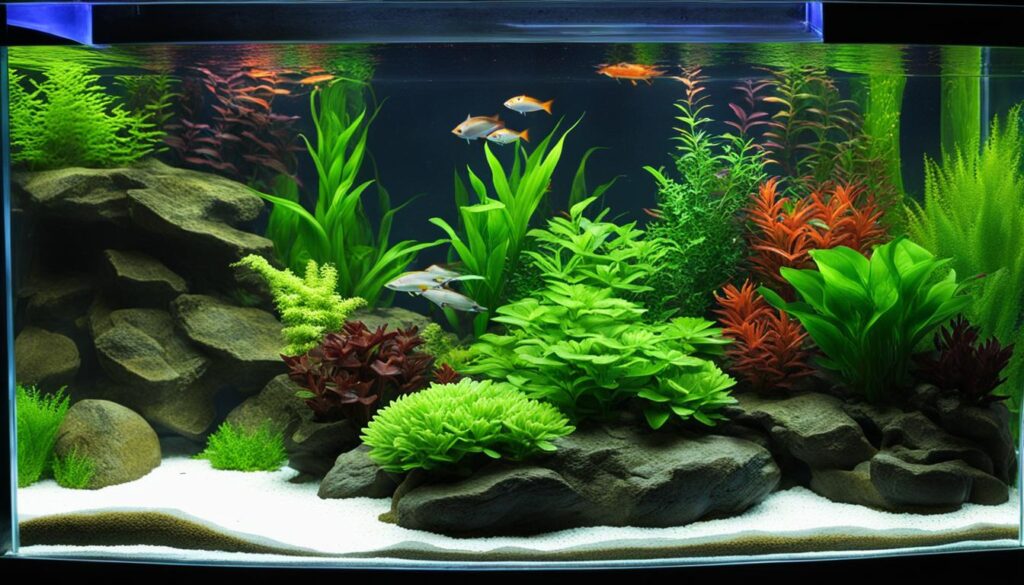
The Benefits of Adequate Lighting for Aquarium Plants
1. Enhanced Growth: Adequate lighting promotes healthy photosynthesis, allowing plants to grow more robustly and develop vibrant colors. It also encourages the formation of new leaves and shoots, resulting in denser and lusher foliage.
2. Oxygen Production: Through photosynthesis, aquatic plants release oxygen into the aquarium, maintaining optimal oxygen levels for fish and other inhabitants. This helps create a balanced and healthy aquatic environment.
3. Algae Control: Proper lighting helps control and prevent excessive algae growth. By providing sufficient light to healthy plants, you can outcompete algae for nutrients, reducing the likelihood of algae blooms.
Table: Comparing Different Types of Aquarium Lighting
| Type of Lighting | Advantages | Disadvantages |
|---|---|---|
| Fluorescent Tubes | – Affordable and widely available
– Suitable for low to medium-light plants |
– Limited spectrum options
– Less energy-efficient compared to LED lights |
| LED Lights | – Energy-efficient and long-lasting
– Wide range of spectrum options – Can simulate natural daylight |
– Higher initial cost
– Limited penetration in deep tanks |
| High-Intensity Discharge (HID) Lights | – High light intensity
– Suitable for high-light demanding plants |
– Expensive and specialized equipment required
– Generates significant heat |
When choosing the right lighting for your aquarium plants, consider the specific light requirements of your plant species, the size and depth of your tank, and your budget. Remember that different plants have varying light intensity preferences, and providing the optimal conditions for their growth is essential. By providing adequate lighting, you will create a thriving and visually stunning underwater garden in your aquarium.
Understanding Aquarium Lighting
Aquarium lighting is crucial in providing the necessary light spectrum for plant growth in an aquarium. It consists of both natural sunlight and artificial light sources. Sunlight provides UV rays that stimulate pigments in plant cells and aid in photosynthesis. Artificial light, such as fluorescent tubes or LED lights, can replicate the necessary light spectrum for plants to thrive in aquariums.
When it comes to effective lighting for aquarium plants, it’s important to understand the different types of bulbs and fixtures available. Fluorescent bulbs are commonly used and come in various lengths and wattages. They emit light in the blue/green spectrum, which is suitable for low-growing or floating plants. T5 bulbs have gained popularity due to their higher intensity, while LED lights offer energy efficiency and customizable options.
Lighting duration is another factor to consider. Most planted aquariums require no more than 8 hours of light per day to prevent issues such as algae growth. New setups may require shorter lighting durations in the first month to prevent algae outbreaks. It’s important to monitor and adjust lighting as needed to promote healthy plant growth.
In summary, understanding aquarium lighting is essential for the growth and health of plants in your aquarium. By choosing the right type of light bulb and fixture, considering factors such as light intensity and duration, and monitoring the overall lighting setup, you can create an optimal environment for your aquatic plants to thrive.
Table: Types of Aquarium Light Bulbs and Fixtures
| Bulb Type | Description | Suitability |
|---|---|---|
| Fluorescent bulbs | Come in various lengths and wattages. Emit light in the blue/green spectrum. | Suitable for low-growing or floating plants. |
| T5 bulbs | Higher intensity compared to fluorescent bulbs. | Suitable for plants with moderate light requirements. |
| LED lights | Energy-efficient and customizable options. | Suitable for all types of plants and tanks. |
Choosing the Right Aquarium Light Bulb for Plants
When it comes to aquarium lighting for plants, choosing the right light bulb is crucial for their growth and overall health. Different types of bulbs emit different light spectrums, and it’s important to select a bulb that provides the necessary wavelengths for photosynthesis and promotes healthy plant growth. The two most popular options are fluorescent tubes and LED lights.
Fluorescent Tubes
Fluorescent tubes have long been used in aquariums for their affordability and availability in various lengths and wattages. These bulbs emit light in the blue/green spectrum, which is suitable for low-growing or floating plants. They can provide adequate lighting for most aquarium plants, especially those that do not have high light intensity requirements.
LED Lights
LED lights have gained popularity in recent years due to their energy efficiency, longevity, and customizable options. LED bulbs can emit a wide range of light spectrums, including red, blue, and white, allowing you to tailor the lighting to the specific needs of your aquarium plants. They also produce less heat and can be dimmed or brightened to simulate natural daylight cycles.
When choosing between fluorescent tubes and LED lights, consider factors such as your budget, the specific light requirements of your plants, and the overall aesthetic you want to achieve in your aquarium. LED lights may have a higher upfront cost but can save you money in the long run due to their energy efficiency and longer lifespan.
| Bulb Type | Pros | Cons |
|---|---|---|
| Fluorescent Tubes | Affordable and widely available | May not provide enough light for high-light plants |
| LED Lights | Energy-efficient and long-lasting | Higher upfront cost |
Ultimately, the best lighting option for your aquatic plants will depend on your specific needs and preferences. Both fluorescent tubes and LED lights can provide effective lighting for planted aquariums, but LED lights offer more versatility and customization options. Consider the requirements of your plants, the aesthetics you want to achieve, and your budget when making your decision.
The Basic Structure of Aquarium Lighting for Plants
When it comes to aquarium lighting for plants, understanding the basic structure is essential for creating a healthy and vibrant environment for your aquatic plants. Most hobbyists opt for fluorescent tubes, which come in various lengths and typically contain one or more bulbs. These tubes are powered by a ballast unit that regulates the power supply. The choice of fluorescent tubes is popular due to their availability and affordability, making them a practical option for both beginners and experienced aquarists.
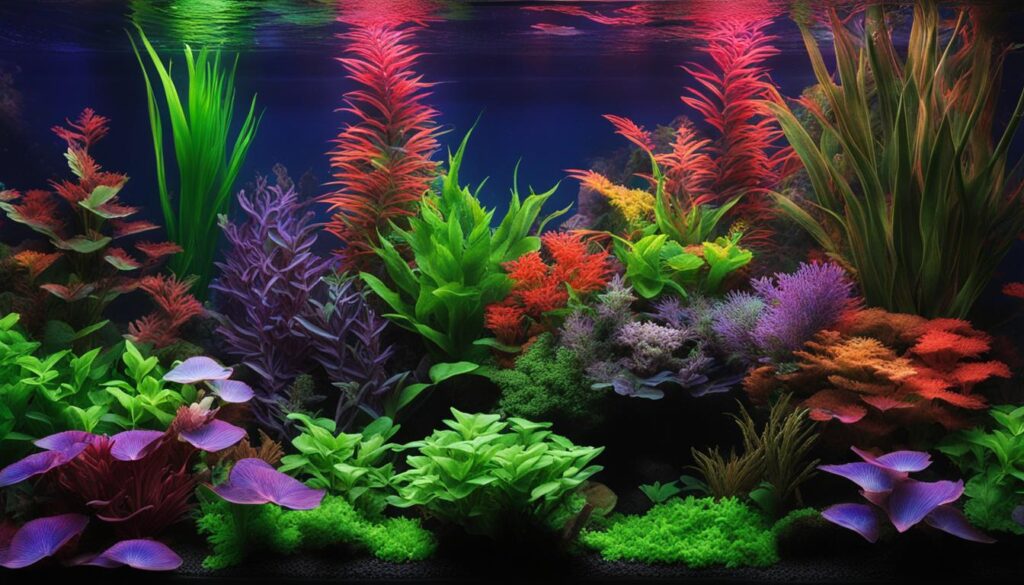
One important consideration for aquarium lighting is ensuring appropriate light levels for each plant species. Different plants have varying light requirements, and providing the right amount of light for optimal growth is crucial. Some plants may thrive under low light conditions, while others may require intense lighting. Understanding the light needs of your specific plants will help you determine the number of bulbs or tubes required and the duration of lighting.
When setting up your aquarium lighting, it is crucial to consider the size and dimensions of your tank. Larger tanks may require multiple fluorescent tubes to provide adequate light coverage, while smaller tanks may only need one or two tubes. Ensuring even distribution of light throughout the tank is essential to prevent shadowing and promote healthy plant growth. Positioning the tubes parallel to the longer sides of the tank is recommended for optimal light spread.
Benefits of Using Fluorescent Tubes for Aquarium Lighting
Fluorescent tubes offer several advantages when it comes to aquarium lighting for plants. Firstly, they emit a wide spectrum of light that includes both blue and red wavelengths, essential for photosynthesis. This allows for balanced plant growth and promotes healthy development. Additionally, fluorescent tubes are energy-efficient and have a long lifespan, making them a cost-effective option for long-term use. These tubes also produce less heat compared to other lighting options, reducing the risk of overheating and maintaining a stable temperature in the tank.
| Advantages of Fluorescent Tubes for Aquarium Lighting |
|---|
| Wide spectrum of light for balanced plant growth |
| Energy-efficient and long-lasting |
| Produces less heat, reducing the risk of overheating |
Factors to Consider When Choosing Aquarium Lights for Plant Growth
When it comes to growing plants in your aquarium, choosing the right lighting is crucial for their overall health and success. There are several factors that you should consider when selecting aquarium lights that will effectively support plant growth.
Type of Tank
Firstly, you need to consider the type of tank you have. Different types of aquariums, such as freshwater or saltwater, may have different lighting requirements. For example, high-light aquatic plants in a freshwater tank will require more intense lighting compared to low-light plants in a saltwater tank.
Size of the Tank
The size of your tank will also affect your choice of lighting. Larger tanks generally require more powerful lights to ensure that all areas of the tank receive adequate light. On the other hand, smaller tanks may only require a single light fixture or a lower-wattage bulb.
Light Requirements of the Plants
Each plant species has its own specific light requirements. Some plants thrive in low-light conditions, while others require higher light intensities. It is important to research the light requirements of the plants you intend to grow in your aquarium and choose lighting that can meet those specific needs.
Best Fixtures for Your Situation
There are various types of lighting fixtures available for aquariums, including fluorescent tubes, LED lights, and metal halide lamps. Each type of fixture has its own advantages and disadvantages. LED lights, for example, are energy-efficient and can provide customizable options, while fluorescent tubes are a more affordable option. Consider your budget and the specific needs of your plants when choosing the best fixture for your situation.
Color-Changing Lights
If you want to create a more dynamic and visually appealing aquarium, you may also consider lights that can change colors based on sunrise and sunset times. These lights can simulate natural lighting conditions and provide a more natural habitat for your plants and fish.
By taking these factors into consideration, you can select the right aquarium lights that will effectively support the growth and health of your plants. Remember to choose lighting that meets the specific needs of your plants, tank size, and budget. With the right lighting, you can create a beautiful and thriving aquatic environment in your aquarium.
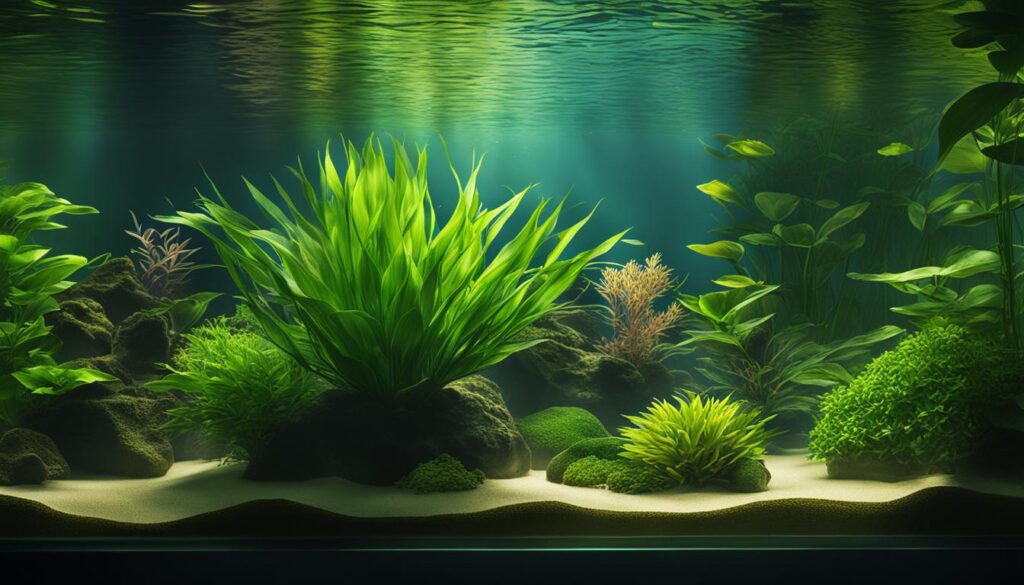
The Different Types of Aquarium Light Bulbs and Fixtures
When it comes to choosing the right aquarium light bulbs and fixtures for your plants, there are several options to consider. Each type of bulb and fixture has its own advantages and considerations, so it’s important to understand the differences before making a decision.
Fluorescent Bulbs
Fluorescent bulbs are the most common type of aquarium light bulbs used for plant growth. They come in various lengths and wattages, making them versatile for different tank sizes and light intensity requirements. Fluorescent bulbs emit light in the blue/green spectrum, which is suitable for low-growing or floating plants. They are generally more affordable and widely available compared to other options.
T5 Bulbs
T5 bulbs have gained popularity in recent years due to their higher intensity compared to fluorescent bulbs. They produce a bright and powerful light, making them ideal for aquariums with high-light plant species. T5 bulbs are more energy-efficient and provide better color rendering compared to traditional fluorescent bulbs. However, they can be more expensive and require specific fixtures designed for T5 bulbs.
LED Lights
LED lights have become increasingly popular for aquarium lighting due to their energy efficiency, long lifespan, and customizable options. LED lights offer a wide range of color spectrums, allowing you to tailor the lighting to the specific needs of your plants. They also emit less heat, reducing the risk of overheating your aquarium. While LED lights may have a higher upfront cost, they can save you money in the long run on energy consumption and replacement bulbs.
| Type of Light Bulb | Advantages | Considerations |
|---|---|---|
| Fluorescent | – Affordable and widely available – Suitable for low-growing or floating plants |
– Emit light in the blue/green spectrum – Less power and intensity compared to other options |
| T5 | – Higher intensity compared to fluorescent bulbs – Better color rendering – Energy-efficient |
– More expensive than fluorescent bulbs – Require specific fixtures |
| LED | – Energy-efficient and long-lasting – Customizable color spectrums – Emit less heat |
– Higher upfront cost – May require additional equipment for customization |
When selecting the right type of aquarium light bulb and fixture for your plants, consider factors such as your budget, the lighting needs of your plants, and the specific features of each type. It’s also important to ensure that the light intensity and spectrum provided by the chosen bulb and fixture meet the requirements of your plant species for optimal growth and health.
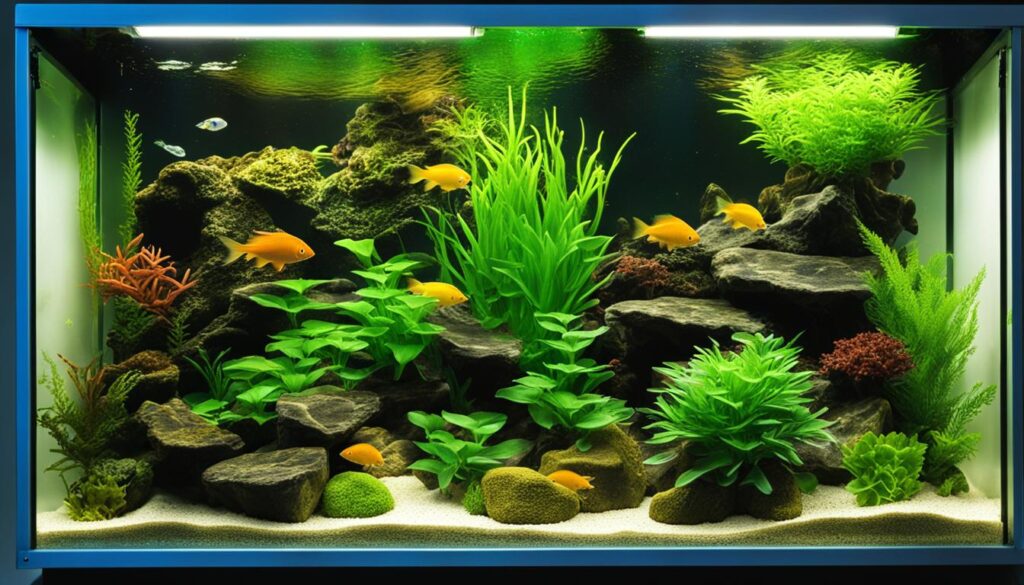
Determining the Power and Wattage of Aquarium Lights
When it comes to choosing aquarium lights for your plants, determining the appropriate power and wattage is crucial. The size of your tank and the light requirements of your plants will play a significant role in this decision.
If you have a larger tank, you will generally need more powerful lights to provide adequate coverage and intensity. Conversely, smaller tanks may require lower-wattage lights to avoid excessive light that could harm your plants.
It’s important to research the specific light requirements for the plants you have in your aquarium. Some plants require higher levels of light to thrive, while others may prefer lower levels. By understanding the individual needs of your plants, you can choose the appropriate wattage to support their growth.
Additionally, consider the type of lights you are using. LED lights are known for their energy efficiency and can provide ample light for plant growth with lower wattage. Fluorescent lights, on the other hand, may require higher wattage to achieve the same light levels.
Table: Power and Wattage Recommendations for Different Tank Sizes
| Tank Size | Recommended Power and Wattage |
|---|---|
| 10-20 gallons | 15-25 watts |
| 30-50 gallons | 30-50 watts |
| 60-100 gallons | 50-100 watts |
Remember, these recommendations are general guidelines and may vary depending on the specific needs of your plants. It’s always best to consult individual plant care guides or seek advice from experienced aquarium enthusiasts or professionals.
By carefully considering the size of your tank, the light requirements of your plants, and the wattage of your chosen lights, you can create an optimal lighting setup for your aquarium plants and promote their healthy growth.
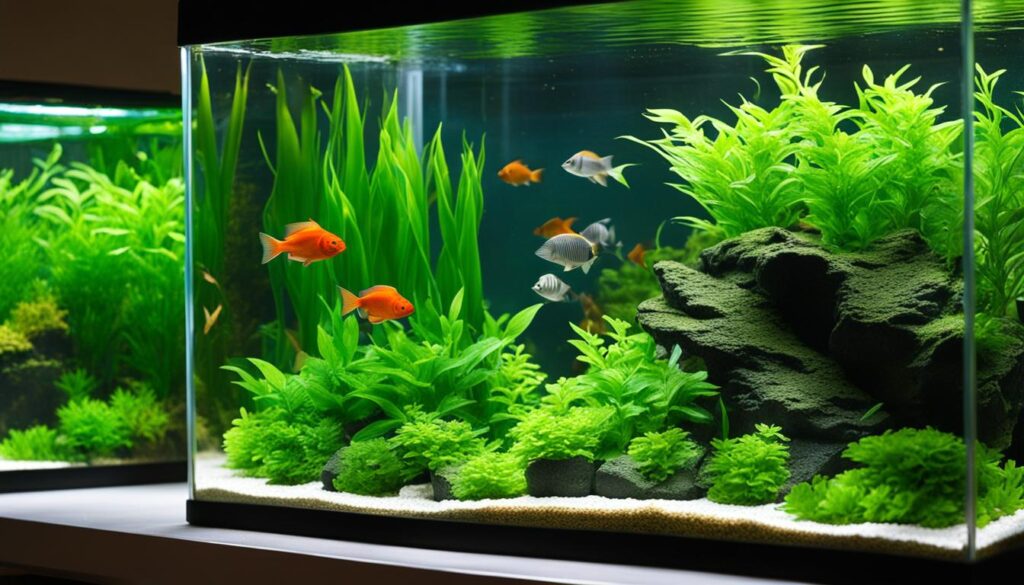
Optimal Lighting Durations for Aquariums
Setting the correct lighting duration is crucial for maintaining a healthy balance in your aquarium and preventing issues such as algae growth. Most planted aquariums require no more than 8 hours of light per day to ensure optimal plant growth and prevent the overgrowth of algae. However, it’s important to note that the lighting duration may vary depending on the specific needs of your plants and the overall setup of your aquarium.
When starting a newly planted aquarium, it is recommended to begin with shorter lighting durations in the first month. This helps prevent algae outbreaks during the initial phase when the plants are still establishing their root systems. Gradually increase the lighting duration by 1-2 hours per day until you reach the desired 8-hour mark.
It’s worth mentioning that some aquarium enthusiasts prefer to simulate natural lighting cycles by providing a period of darkness at night. This can be achieved by using timers to automatically turn off the lights in the evening and back on in the morning. By replicating the natural day-night cycle, you can create a more natural and balanced environment for your aquarium plants.
Table: Recommended Lighting Durations for Different Types of Plants
| Plant Type | Lighting Duration |
|---|---|
| Low-light plants (e.g., anubias, java fern) | 6-8 hours per day |
| Medium-light plants (e.g., rotala, cryptocoryne) | 8-10 hours per day |
| High-light plants (e.g., carpeting plants, red ludwigia) | 10-12 hours per day |
Remember that these durations are general guidelines, and you should always observe how your plants respond to the lighting conditions. It’s essential to monitor your plants regularly for signs of stress or excessive growth. Adjustments to the lighting duration may be necessary based on the specific needs of your aquarium plants.
By providing an optimal lighting duration and closely monitoring your plants’ response, you can create a thriving and visually appealing aquarium that fosters healthy plant growth while keeping algae at bay.
Understanding Color Temperatures in Aquarium Lighting
Color temperature plays a significant role in the appearance and growth of plants in your aquarium. While plants can grow under a wide range of color spectrums, a neutral white light around 5000 to 6500 K is often preferred to simulate natural daylight. This color temperature provides a balanced spectrum of light that promotes photosynthesis and healthy plant growth.
When choosing aquarium lighting for plants, it’s important to understand the relationship between color temperature and light output. Lower color temperatures, such as warm white or red light, tend to promote flowering and fruiting in plants. On the other hand, higher color temperatures, such as cool white or blue light, encourage leafy growth and can enhance the coloration of aquarium fish.
“The color temperature of light primarily depends on personal preference and the desired aesthetic you want to achieve in your aquarium,” says Dr. Anne Smith, aquatic plant expert. “However, it’s crucial to provide a color temperature that meets the light requirements of your specific plants to ensure their optimal growth and overall health.”
It’s worth noting that different aquarium plants have varying light intensity preferences, and the color temperature alone may not be sufficient to promote optimal growth. Some plants may require additional light intensity or specific light wavelengths. Therefore, it’s essential to consider both color temperature and light intensity when selecting the right lighting for your aquarium plants.
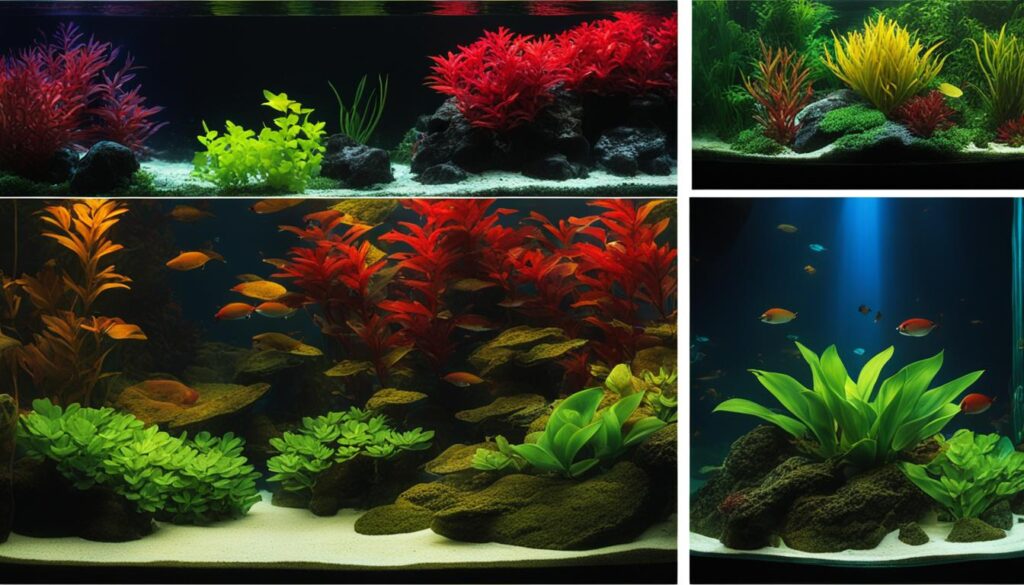
| Color Temperature (K) | Light Appearance | Plant Growth |
|---|---|---|
| 2500-3000 | Warm White | Promotes flowering and fruiting |
| 3500-4500 | Neutral White | Simulates natural daylight; promotes overall plant growth |
| 5000-6500 | Cool White | Enhances leafy growth; enhances fish coloration |
By understanding the concept of color temperatures in aquarium lighting and considering the light requirements of your specific plants, you can create an optimal lighting environment that promotes the growth and health of your aquarium plants.
Evaluating Light Intensity Levels for Different Types of Plants
When it comes to providing the right lighting for your aquatic plants, understanding the different light intensity levels required by each plant type is crucial. Different plants have varying needs when it comes to the amount of light they require for optimal growth. By evaluating and adjusting the light intensity levels in your aquarium, you can ensure that your plants thrive and flourish.
Low-Light Plants
Low-light plants, such as anubias and ferns, have adapted to survive in areas with limited light. These plants can thrive with lower light intensity levels, making them ideal for aquariums with weaker lighting systems. Typically, low-light plants require around 15-30 PAR (Photosynthetic Active Radiation) to grow successfully. It is important to provide them with enough light to sustain photosynthesis without causing algae issues.
Medium-Light Plants
Medium-light plants, including stem plants like rotala and ludwigia, require a bit more light intensity to grow properly. These plants typically need around 35-50 PAR to maintain healthy growth. Providing moderate lighting will ensure that they can perform photosynthesis efficiently and develop lush foliage. It’s important to strike a balance and avoid excessive lighting that can lead to algae problems.
High-Light Plants
High-light plants, such as carpeting plants like dwarf baby tears and hairgrass, demand intense lighting to thrive. These plants need at least 50-80 PAR or more to support their rapid growth and vibrant colors. It is crucial to provide them with high-intensity lighting, along with other factors like CO2 injection and nutrient supplementation, to ensure optimal growth. However, it’s important to monitor these plants closely as they can be more demanding and require additional care.
| Plant Type | Light Intensity Level (PAR) |
|---|---|
| Low-Light Plants | 15-30 |
| Medium-Light Plants | 35-50 |
| High-Light Plants | 50-80+ |
Understanding the light intensity requirements of different types of plants in your aquarium will help you create a lighting setup that promotes healthy growth. By providing the appropriate light intensity levels, you can ensure that your plants receive the right amount of energy for photosynthesis, prevent algae issues, and create a stunning underwater ecosystem.
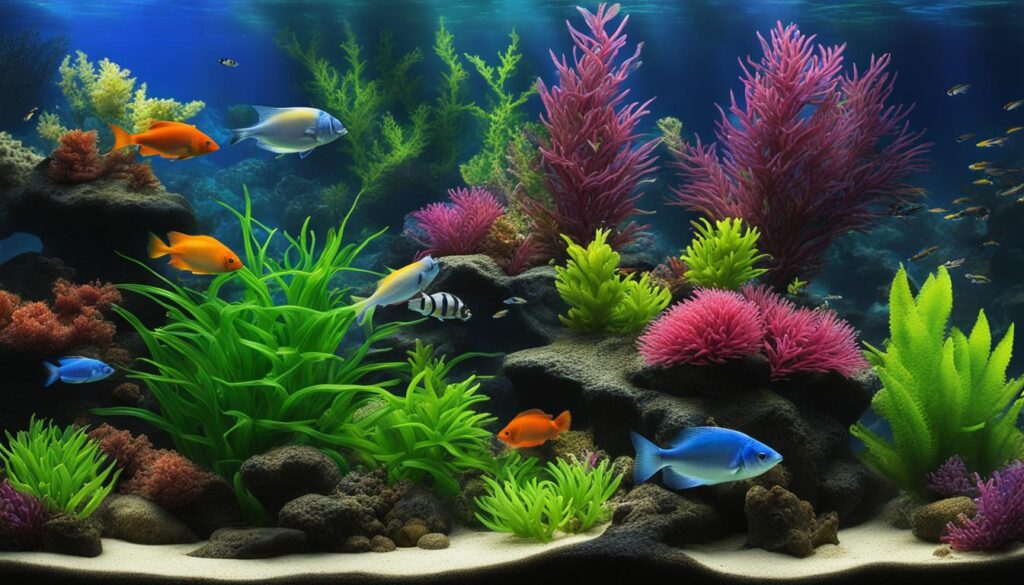
The Importance of Light Spread in Aquarium Lighting
Light spread plays a crucial role in ensuring effective lighting for aquarium plants. Proper light distribution is essential to ensure that all plants receive sufficient light for photosynthesis and growth. Without adequate light spread, certain areas of the tank may receive too much light, while others may be left in shadow, leading to uneven plant growth and potential nutrient deficiencies.
To achieve optimal light spread, it is important to consider the width and depth of your aquarium. A single light fixture may be sufficient for smaller tanks, but larger tanks may require multiple lights strategically placed to ensure even coverage. Consider using reflective surfaces or light reflectors to redirect and distribute light more evenly throughout the tank.
Maximizing Light Spread: Tips and Techniques
- Position your light fixture(s) at an appropriate height above the water surface. This will help distribute light more evenly and reduce the risk of creating intense hot spots.
- Use a combination of direct and indirect lighting. Direct lighting refers to light directly shining on the plants, while indirect lighting uses light reflected off walls or other surfaces to provide additional coverage.
- Consider the use of light diffusers or spreader lenses to help spread the light more evenly across the tank.
- Regularly check and adjust the positioning of your lights to ensure consistent coverage as plants grow and change shape.
By focusing on achieving optimal light spread, you can create a balanced and conducive environment for healthy plant growth in your aquarium. Remember to regularly monitor your plants for signs of inadequate or excessive lighting, adjusting as necessary to maintain optimal conditions.
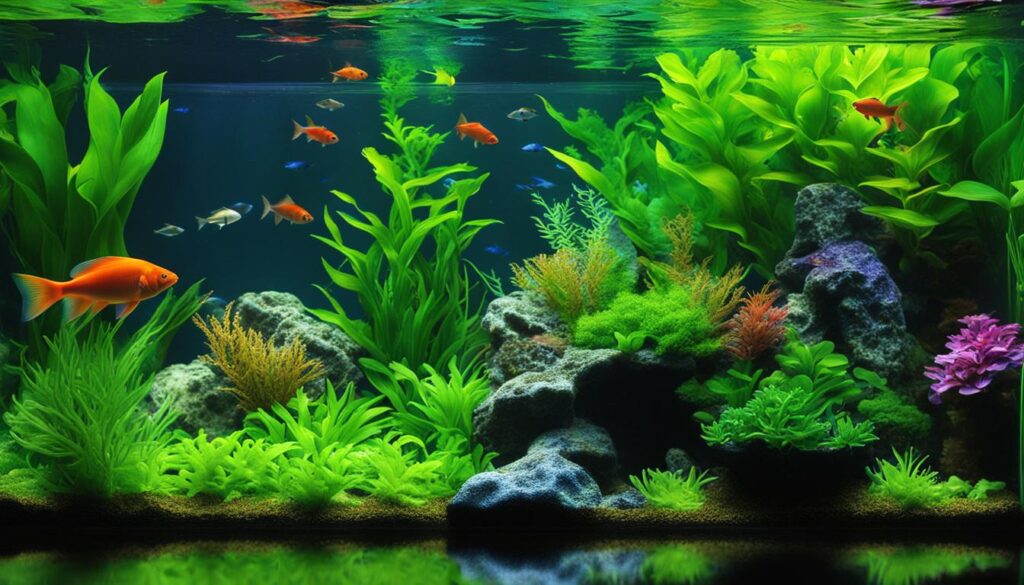
| Pros of Effective Light Spread | Cons of Inadequate Light Spread |
|---|---|
|
|
Factors to Consider in Choosing the Best Aquarium Light
Aquarium lighting plays a crucial role in the growth and health of your plants. When choosing the best aquarium light for your plants, it’s important to consider several factors to ensure optimal results. By taking these factors into account, you can create a lighting setup that promotes healthy plant growth and enhances the overall aesthetic of your aquarium.
1. Goals and Objectives
Before diving into the specifics of aquarium lighting, it’s important to determine your goals and objectives. Are you looking to create a lush, heavily planted tank or a minimalist aquascape? Understanding your desired outcome will help you narrow down your options and select the appropriate light fixture that will meet your specific needs.
2. Light Intensity Requirements
Different plant species have varying light intensity requirements. Some plants thrive under low-light conditions, while others require higher light intensities. Take into consideration the light requirements of your chosen plants and select a light fixture that can deliver the necessary intensity levels.
3. Tank Dimensions
The dimensions of your tank will also impact your choice of lighting. Larger tanks may require multiple light fixtures to ensure even light distribution, while smaller tanks may only need one. Consider the width and depth of your tank to determine the number and placement of light fixtures required for optimal coverage.
4. Budget
When choosing an aquarium light, budget is an important factor to consider. LED lights are a popular choice for their energy efficiency and long lifespan, although they can be more expensive upfront. Evaluate your budget and prioritize the features that are most important to you to make an informed decision.
5. Value and Quality
Lastly, consider the overall value and quality of the aquarium light. Look for lights that offer a good balance between price, functionality, and durability. Reading customer reviews and seeking recommendations from experienced hobbyists can help you gauge the performance and reliability of different lighting options.
By considering these factors when choosing the best aquarium light for your plants, you can create an optimal lighting setup that supports healthy plant growth and enhances the beauty of your aquatic environment.
“The right aquarium light can make all the difference in the growth and overall health of your plants. By carefully considering your goals, light intensity requirements, tank dimensions, budget, and the overall value and quality of the light fixture, you can choose the best option for your aquarium.” – Experienced Aquarist
| Factors to Consider | Importance |
|---|---|
| Goals and Objectives | ✓ |
| Light Intensity Requirements | ✓ |
| Tank Dimensions | ✓ |
| Budget | ✓ |
| Value and Quality | ✓ |
The Aquarium Co-Op Easy Plant LED – A Recommended Option
When it comes to finding the best lighting for aquatic plants in your planted aquarium, the Aquarium Co-Op Easy Plant LED is a highly recommended option. This LED light fixture offers a range of features that make it an ideal choice for promoting plant growth and creating a visually stunning aquarium.
The color spectrum of the Aquarium Co-Op Easy Plant LED is designed to mimic natural daylight, providing the ideal lighting conditions for your plants. With adjustable brightness settings, you can easily customize the light intensity to suit the needs of your specific plant species. Whether you have low light plants or high light plants, this LED fixture can accommodate their requirements.
Not only does the Aquarium Co-Op Easy Plant LED provide optimal lighting for your plants, but it also offers energy efficiency and longevity. LED lights are known for their low energy consumption, helping you save on electricity costs. Additionally, LEDs have a longer lifespan compared to traditional light bulbs, reducing the need for frequent replacement.
With a 3-year warranty, you can have peace of mind knowing that the Aquarium Co-Op Easy Plant LED is a durable and reliable lighting option for your planted aquarium. Enhance the beauty of your aquatic plants with this recommended LED fixture and create an environment where your plants can thrive.
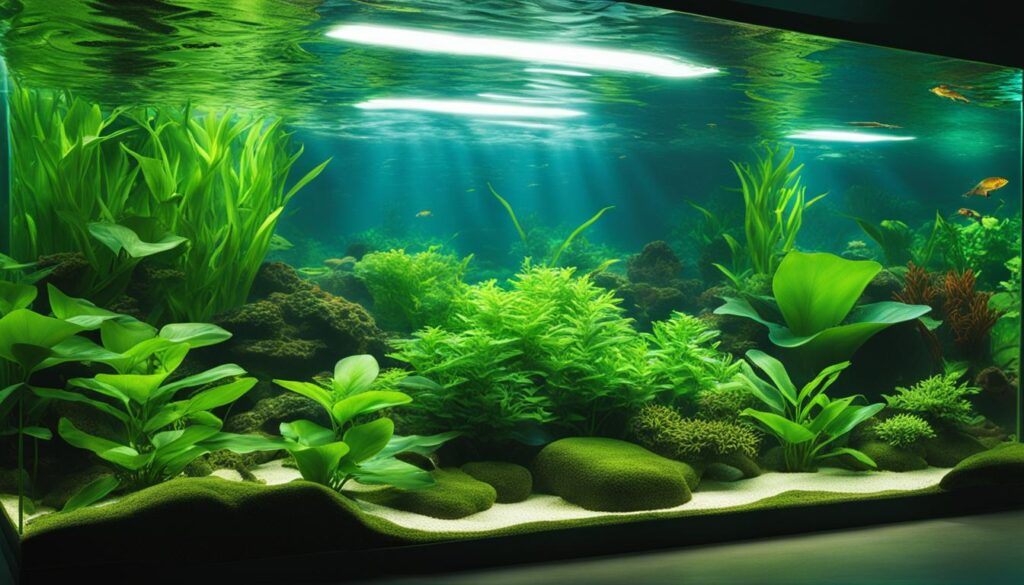
Table: Comparison of Lighting Options for Planted Aquariums
| Lighting Option | Color Spectrum | Brightness Settings | Energy Efficiency | Lifespan | Warranty |
|---|---|---|---|---|---|
| Aquarium Co-Op Easy Plant LED | Natural Daylight | Adjustable | High | Long-lasting | 3 years |
| Fluorescent Bulbs | Blue/Green Spectrum | No adjustable settings | Moderate | Shorter lifespan | No warranty |
| T5 Bulbs | Varies based on bulb | No adjustable settings | Moderate | Shorter lifespan | No warranty |
| Other LED Fixtures | Varies based on fixture | Varies based on fixture | High | Long-lasting | Varies based on the manufacturer |
Additional Tips for Successful Aquarium Lighting for Plants
When it comes to aquarium lighting for plants, there are a few extra tips that can help ensure successful plant growth. These tips will help you maintain the right light intensity, duration, and spread throughout your tank, promoting healthy and vibrant plants. Here are some key considerations:
1. Proper Light Intensity
It’s important to provide your plants with the right amount of light intensity. This will vary depending on the specific plant species you have in your aquarium. Low-light plants, such as anubias and java ferns, thrive with lower light levels, while high-light plants like carpeting or stem plants require more intense lighting. Adjust the positioning and power of your light source accordingly to meet the needs of your plants.
2. Avoid Excessive Lighting Periods
While it’s crucial to provide enough light for your plants, it’s equally important to avoid excessive lighting periods. Leaving the lights on for too long can lead to algae overgrowth and imbalanced tank conditions. Most planted aquariums do well with 8 hours of light per day. If you’re just starting a new planted tank, consider shorter lighting durations for the first month to prevent algae outbreaks.
3. Ensure Adequate Light Spread
To ensure all your plants receive sufficient light, it’s important to consider the spread or dispersal of light in your aquarium. Take into account the width and depth of your tank when positioning your lights. If you have a larger tank, you may need multiple lights to achieve even coverage. Aim for a balanced spread of light to provide equal opportunities for all your plants to thrive.
By following these additional tips, you can create an optimal lighting environment for your aquarium plants. Remember to adjust the light intensity, duration, and spread based on the specific needs of your plant species. With the right lighting setup, your plants will flourish and enhance the beauty of your aquarium.
Conclusion
In conclusion, aquarium lighting plays a crucial role in the growth and health of plants in your aquarium. By understanding the importance of lighting for plant growth and choosing the right light bulb, you can create an optimal lighting setup for your aquatic plants.
When selecting aquarium lights, consider factors such as the light intensity requirements of your plants, the dimensions of your tank, and your budget. LED lights, like the Aquarium Co-Op Easy Plant LED, are a recommended option for their energy efficiency and versatility.
Remember to maintain proper light intensity, avoid excessive lighting periods, and ensure adequate light spread throughout your tank. Monitoring and adjusting your lighting as needed can promote healthy and thriving plant growth in your aquarium.
FAQ
Why is aquarium lighting important for plant growth?
Aquarium lighting is essential for plants as they require both sunlight and artificial light to undergo photosynthesis and produce food. Without proper lighting, plants cannot grow and thrive in the aquarium environment.
What types of lights are used for aquarium plants?
Aquarium lighting consists of both natural sunlight and artificial light sources. Sunlight provides UV rays that stimulate pigments in plant cells and aid in photosynthesis. Artificial light, such as fluorescent tubes or LED lights, can provide the necessary light spectrum for plant growth in an aquarium.
How do I choose the right light bulb for my aquarium plants?
The type of light bulb you choose is crucial for plant growth. Different bulbs emit different light spectrums. It’s important to choose a bulb that provides the necessary wavelengths for photosynthesis and promotes healthy plant growth.
What factors should I consider when choosing aquarium lights for plant growth?
Several factors should be considered, such as the type and size of your tank, the light requirements of your plants, the best fixtures for your situation, and whether you want lights that can change colors based on sunrise and sunset times.
What are the different types of aquarium light bulbs and fixtures available?
There are different types available, such as fluorescent bulbs (in various lengths and wattages), T5 bulbs (higher intensity), and LED lights (energy-efficient and customizable options).
How do I determine the power and wattage of aquarium lights?
The power and wattage depend on your tank’s size and the plants’ light requirements. Larger tanks typically require more light, while smaller tanks may need less. Choose the appropriate wattage based on the needs of your specific plant species.
How long should I keep the lights on in my aquarium?
Most planted aquariums require no more than 8 hours of light per day. Newly planted aquarium setups may require shorter lighting durations in the first month to prevent algae outbreaks.
What color temperature is best for aquarium lighting?
While plants can grow under a wide range of color spectrums, a neutral white light around 5000 to 6500 K is often preferred to simulate natural daylight. The color of light primarily depends on personal preference.
What types of plants have different light intensity requirements?
Different plants have varying light intensity requirements. Low-light plants can thrive with low-intensity lighting, while medium-light plants require moderate lighting. High-light plants can grow under intense lighting but often require additional measures such as carbon dioxide injection.
How can I ensure all plants receive sufficient light in my aquarium?
The spread or dispersal of light in an aquarium is important. Most aquarium lights have a light spread directly below them, so it’s important to consider the width and depth of your tank to determine the number of lights needed for even coverage.
What is the recommended option for aquarium lighting?
The Aquarium Co-Op Easy Plant LED is a recommended option for its color spectrum mimicking natural daylight, adjustable brightness for low and high light plant growth, energy efficiency, and longevity, and comes with a 3-year warranty.
Are there any additional tips for successful aquarium lighting for plants?
Yes, maintaining proper light intensity, avoiding excessive lighting periods, ensuring adequate light spread throughout the tank, and monitoring and adjusting lighting are essential for promoting healthy plant growth.
